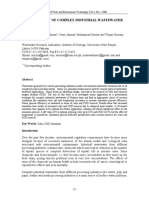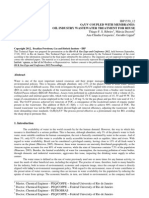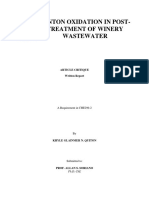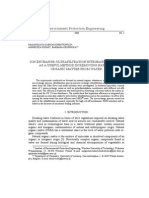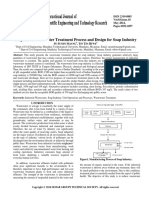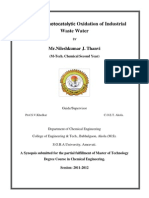Ozone in Waste Water Treatment: Achim Ried
Ozone in Waste Water Treatment: Achim Ried
Uploaded by
Mai ElsomkhratyCopyright:
Available Formats
Ozone in Waste Water Treatment: Achim Ried
Ozone in Waste Water Treatment: Achim Ried
Uploaded by
Mai ElsomkhratyOriginal Title
Copyright
Available Formats
Share this document
Did you find this document useful?
Is this content inappropriate?
Copyright:
Available Formats
Ozone in Waste Water Treatment: Achim Ried
Ozone in Waste Water Treatment: Achim Ried
Uploaded by
Mai ElsomkhratyCopyright:
Available Formats
OZONE SCIENCE AND TECHNOLOGY - Ozone in Waste Water Treatment - Achim Ried, Jörg Mielcke
OZONE IN WASTE WATER TREATMENT
Achim Ried
ITT WEDECO GmbH Boschstr. 6 32051 Herford Germany
Jörg Mielcke
ITT WEDECO GmbH Boschstr. 6 32051 Herford Germany
Keywords: Ozone; biological treatment; full-scale; partial ozonation; process
combination; waste water, cost
Contents
1. Introduction
2. Implementation of large scale plants
3. Combined biological treatment and ozonation
4. Industrial waste water treatment
4.1. Decolorization
4.2. Disinfection of waste water
5. References for full scale applications
5.1. Tubli plant/Bahrain – municipal waste water
5.2. Ranica/Italy – municipal waste water
5.3. Kalundborg/Denmark – municipal waste water
5.4. Lang Papier/Germany – paper industry
5.5. Fat melting industry – reduction of odorous compounds
5.6. Chemical Industry – reduction of hardly biodegradable compounds
6. New trends for the usage of ozone in waste water treatment
6.1. Sludge treatment
6.2. Advanced oxidation
6.3. Reduction of emerging contaminants
7. Cost calculations
8. Conclusions
Acknowledgement
Bibliography
Summary
The combination of biological treatment with ozonation is the most important approach
to apply ozone in the field of waste water processing. Beside the synergistic effects of
such process combination, which lead to oxidation of recalcitrant and inhibitory
compounds or intermediates by enhancement of their biodegradability, the key for
raising applicability is the improvement of the ozonation efficiency. An overview about
the history and progress of full scale applications is given. Beside this option other
applications are described and an overview of full-scale installations is given. Landfill
leachate and industrial waste water are mostly processed, while treatment of municipal
waste water is of increasing interest due to several benefits such as disinfection,
decolorization and removal of persistent dissolved organic carbon (DOC), EDCs or
pharmaceuticals for water re-use and groundwater recharge.
©Encyclopedia of Life Support Systems (EOLSS)
OZONE SCIENCE AND TECHNOLOGY - Ozone in Waste Water Treatment - Achim Ried, Jörg Mielcke
1. Introduction
As an indication of technical standard and civilization waste water is handled and
processed for many different reasons. All these activities have in common that
contaminants have to be degraded, changed in their constitution or removed. Three
main technologies are relevant for this purpose:
(a) Degradation of contaminants by biological treatment
(b) Separation of contaminants by flocculation, adsorption or membrane technique
(c) Degradation of contaminants by chemical oxidation.
Among processes, which purify waste water by means of chemical oxidation, ozone
treatment has established itself steadily increasing as a powerful, effective and
economic oxidation step.
The reasons for this predominance are the manifold application options and the
compliance with high level environmental requirements and the reliable technical
equipment.
The reuse or discharge of waste water can be limited by color, odor and by the amount
of COD, AOX and/or germs. All these parameters can be significantly reduced by using
ozone. According to the limiting conditions, the necessary average ozone doses are as
follows:
Color ( 436nm ) (down to< 7/m) 5-50 gO3/m³
COD (down to < 20 mg/l) 50-150 g O3/m³
Germs (down to < 10 CFU/ml) 0.1-5 g O3/m³
AOX (down to < 100 µg/l) 50-150 g O3/m³
Figure 1 gives an overview on the relation between ozone dosage and different
treatment effects. For the implementation of an ozonization into existing treatment
processes in every single case the premises have to be considered individually.
Figure 1. Spectrum of ozone activity
Figure 2 presents different options for ozone application at waste water treatment plants.
Generally the following options can be specified:
Treatment of secondary effluents
Excess sludge treatment
Off gas treatment
©Encyclopedia of Life Support Systems (EOLSS)
OZONE SCIENCE AND TECHNOLOGY - Ozone in Waste Water Treatment - Achim Ried, Jörg Mielcke
Treatment of high polluted part streams.
Figure 2. Ozone integration/applications at waste water treatment plants
2. Implementation of Large Scale Ozone Plants
For integration an ozone system onsite a municipal waste water treatment plant the
following key points have to be considered:
necessary ozone dose range (depends on the water matrix and the contaminants)
calculation of the ozone demand (ozone dose * flow rate)
components of an ozone system (ozone generator, gas supply, reaction system, off-
gas handling)
process control, online measurement.
The typical components of an ozone system are described in Figure 3.
Figure 3. General layout of an ozone system
©Encyclopedia of Life Support Systems (EOLSS)
OZONE SCIENCE AND TECHNOLOGY - Ozone in Waste Water Treatment - Achim Ried, Jörg Mielcke
The ozone generator might be installed in a container or integrated in an existing
building. The produced ozone gas can be transported through stainless steel pipes to the
reaction chamber.
The feed gas for the ozone generator (either purified air or oxygen) can be supplied by a
liquid oxygen tank, an air preparation unit or a PSA unit to produce oxygen onsite. The
final decision for the best gas supply is depending on the availability of liquid oxygen,
the cost of liquid oxygen, the energy cost and the amount of ozone to be produced.
Beside the generation of the ozone an appropriate design of the gas transfer and reaction
system is important. Different gas transfer and reactor designs are known. In drinking
water applications it is very common to use diffusers for the gas transfer and specific
designed concrete basins as reaction chambers. This method is also used for the
treatment of municipal waste water.
Beside the diffusers different type of injectors are used to mix the ozone containing gas
with the water flow. Depending on water flow, required ozone dosage and the reaction
kinetics various configurations are applied, e.g. side stream injection, main stream
injection, plug flow pipe reactors and pressurized reaction tanks [Roustan 2000]. For the
ozonation of secondary effluents the usage of diffusers and concrete basins could be
favorable due to utilization of existing basins.
Figure 4. Layout of diffuser basins for ozone treatment
Possible online measurements for controlling the process could monitor the produced
ozone mass (ozone gas concentration * feed gas flow), ozone concentration in the off-
gas, dissolved ozone concentration after the reaction tank. These parameters can be
measured and controlled readily. Without any difficulties the ozone plant can be
operated at variable ozone dosages depending on the actual water flow rate.
3. Combined Biological Treatment and Ozonation
[Ried, Mielcke 1999; Ried, Mielcke et. al. 2000; Ried, Mielcke, Wieland et. al. 2006]
There are manifold ideas how to use oxidants, respectively ozone in the field of waste
water processing. Nevertheless, under the aspect of technical and economic feasibility
©Encyclopedia of Life Support Systems (EOLSS)
OZONE SCIENCE AND TECHNOLOGY - Ozone in Waste Water Treatment - Achim Ried, Jörg Mielcke
the most important approach is to combine the application of ozone with biological
treatment steps.
On that way even high polluted waste waters, like landfill leachates or heavily loaded
effluents from industrial production can be purified. The breakthrough of ozone
applications in waste water treatment was during the beginning of the nineties. Approx.
10 combined ozone-biology applications including larger ozone systems up to 160
(4x40) kgO3/h plants have been completed in 1992, e.g. in the textile industry for
decolorization/tenside destruction and at landfill leachate treatment plants for removal
of recalcitrant compounds.
At that time the post ozonation of biological pre-treated wastewater (BIO-OZONE) was
used. It is interesting to note, that many of those ozone applications have started as
ozone/UV based AOP processes, but by and by the UV systems were switched off due
to the suitable treatment efficiency of BIO-OZONE alone.
Due to the relative high costs for production of ozone and the much lower costs for
biological treatment the first application of the combination “biological pre-treatment –
ozonation – biological post-treatment (BIO-OZONE-BIO)” had been installed at the
end of 1992, shortly after first applications of post-ozonation [Siemers 1995]. In this
landfill leachate BIO-OZONE-BIO application, biological post-treatment was realized
by rotating disks, overgrown with biofilm.
Generally secondary effluents, containing non-further bio-degradable compounds are
successfully treated by means of ozone to carry forward waste water processing. An
advanced, further biological treatment step depends on the enhancement of
biodegradability by the well-dosed usage of ozone. This application gains at partial-
oxidation or “cracking” of intermediate dead-end compounds. The usage of the
synergistic effects of this combination has led to the establishment of this very effective
and economically successful procedure over the years (compare Table 2).
The next step of development for removal of recalcitrant compounds with first
installation in 1995 was the BIOQUINT process, in which the ozonation is placed in a
cycle loop around the second biological treatment step. This integrated ozonation
process is similar to an OZONOBIO multi-step process and comes along the philosophy
“partial oxidation as low as possible and biological oxidation as high as possible”,
which enables lower ozone consumption and therefore a more cost-effective process. In
order to better illustrate the relationships, Figure 5 presents a sample calculation, in
which the corresponding COD degradation behavior is shown as well as the ozone mass
required for the following possible combinations:
(1) biological treatment + ozonation
(2) biological treatment + ozonation + biological treatment
(3) biological treatment + ozonation + biological treatment + ozonation + biological
treatment
To simplify the calculation, the same initial and target concentrations are assumed for a
flow rate of 1 m3/h. Thus, it can be clearly illustrated that the ozone demand decreases
©Encyclopedia of Life Support Systems (EOLSS)
OZONE SCIENCE AND TECHNOLOGY - Ozone in Waste Water Treatment - Achim Ried, Jörg Mielcke
from 2.375 kg ozone/h (A) to 1 kg ozone/h (C) by combining the two processing stages
biological treatment and ozonation.
Obviously biologically degradable portion of the entire COD to be eliminated increases
and the ozone containing portion to be degraded correspondingly decreases. This results
in different ozone factors (proportional ozone demand for the elimination of 1kg COD)
for the individual combinations, whereby the total COD load to be eliminated is
considered taking also biological elimination into account. The requisite ozone factor
decreases from 2.5 (A) to 1.1 (C). The BIOQUINT process, which combines biological
filtration and ozonation in a cyclical process, showed up in practiced ozone factors
lower than 1 kg ozone per kg eliminated COD. The ozone required can be reduced by
more than half by using multi-step treatment schemes. The decreased ozone demand
naturally has a positive effect on the investment costs for the ozone generators as well
as on expenditures for oxygen and electricity [Ried, Mielcke 1999].
raw water 1 m3/h COD [mg/l] (A) COD [mg/l] (B) COD [mg/l] (C)
supply 2,200 2,200 2,200
discharge biology I 1,100 1,100 1,100
discharge ozonation I 150 300 900
discharge biology II 150 500
discharge ozonation II 300
biology III 150
COD-reduction decomposition 2,050 2,050 2,050
COD-reduction biology (I+II+III) 1,100 1,250 1,650
(150+1100) (150+400+1100)
COD-reduction ozonation (I+II) 950 800 400
required ozone mass [g/h] 2375 [g/h] 2000 [g/h]
(COD-reduction ozonation x 2.5) 1000
Figure 5. Example calculation for different combinations biological treatment + ozone
However for higher volumetric flow-rates and lower organic loading rates, e.g. in the
chemical industry, the post-ozonation process BIO-OZONE seems to be more suitable
due to easier operation (of different waste water characteristics based on production
plan) related to the potential of less ozone consumption.
©Encyclopedia of Life Support Systems (EOLSS)
OZONE SCIENCE AND TECHNOLOGY - Ozone in Waste Water Treatment - Achim Ried, Jörg Mielcke
4. Industrial Waste Water Treatment
Many industrial waste water treatment plants utilize activated sludge biology as a final
step of their treatment process. The biological step is able to reduce the biodegradable
part of COD. The biological treatment efficiency can be disturbed by toxic compounds
e.g. phenols in the raw water. In such cases it is recommended to use ozone in a pre-
treatment step to destroy toxic compounds. For this application a typical ozone dosage
is 50-100 g ozone /m³.
In the effluent of the biological step (secondary effluent) usually the remaining, not
biodegradable COD can be still too high in order to meet specific limits for direct
discharge or reuse purposes. At this stage it is promising to use ozone in combination
with a subsequent biofiltration stage. Figure 6 gives an idea of the possible integration
of ozone treatment into an existing industrial biological treatment plant.
In this theoretical example (based on practical data) the raw water COD is 2000 g/m³.
By using an ozone dosage between 50 and 100 g/m³ toxic compounds can be reduced.
E.g. the oxidation of phenol with ozone is very fast. Due to that a reduction of phenol is
possible even with a high COD level in the raw water.
Ozone 0 50-100 g/m³ 0 400 -600 g/m³ 0 0
dosage
no detoxification; biol. COD partly COD BOD disinfection
e.g. phenol reduction; reduction; reduction
effects removal
odour /colour BOD cracking;
reduction reduction decolorisation
Figure 6. Treatment effects by using different techniques
©Encyclopedia of Life Support Systems (EOLSS)
OZONE SCIENCE AND TECHNOLOGY - Ozone in Waste Water Treatment - Achim Ried, Jörg Mielcke
In the effluent of the biological step the hard, not biodegradable COD might be 800
g/m³ (60% COD-reduction). For further practicable and economic treatment COD can
be reduced to 400 g/m³ with an ozone dosage between 400 and 600 g/m³ (additional
50% COD-reduction).
By using a subsequent biofilter step after ozonation it is possible to reduce the COD for
another 30 -40% down to 240 -280 g/m³.
The additional COD reduction in total due to ozonation and biofiltration is appr. 65 -70
%. Using UV technique subsequent to the biofiltration a final disinfection can be
achieved.
4.1. Decolorization
In the huge field of industrial sewage treatment the removal of color is a single problem
that can be solved quite easily by using just small amounts of ozone.
The necessary ozone dosage for color elimination dependents not only on the type of
dye stuff, its concentration and the effluent concentrations, but also on the background
load of COD.
For highly polluted effluents a pre-treatment to reduce the COD to a level as low as
possible is therefore recommended prior to ozone oxidation, particularly to achieve low
ozone consumption levels.
If the level of organic pollution of the waste water is low (COD = 150 -200 mg/l), high
degrees of degradation of 80-90%, with reference to the colors yellow (436 nm), red
(525 nm) and blue (620 nm), can be achieved with low ozone consumption levels
(approximately 50 mg/l) and short reaction periods (about 10 minutes).
Colored effluents can be even reused as process water after ozone oxidation. The ozone
treatment step provides additional benefits besides color reduction such as:
disinfection
reduction of unpleasant odors.
In March 2000 two large scale ozone systems with an ozone capacity of 13 and 7 kg/h
were set in operation in order to reduce color and COD in a dye manufacturer„s effluent.
These installations followed a successful 2 month pilot plant operation performed on
site in 1999.
The effluent parameters (inlet ozone plant) are: Q 25 m³/h, color = 2500 -5000 ADMI,
COD = 250 -800 mg/l. Goal of the treatment is to reduce the color down
to ADMI 400 .
-
-
©Encyclopedia of Life Support Systems (EOLSS)
OZONE SCIENCE AND TECHNOLOGY - Ozone in Waste Water Treatment - Achim Ried, Jörg Mielcke
TO ACCESS ALL THE 27 PAGES OF THIS CHAPTER,
Visit: http://www.eolss.net/Eolss-sampleAllChapter.aspx
Bibliography
[1] Abumaizar R.J. et al. (2003). Disinfection of treated Waste Water for Reuse in Irrigation,
International Conference for water technology, Bahrain 2003, conference papers, 353-363.
[2] Acero J. and von Gunten U. (2001). Characterization of oxidation processes: ozonation and the AOP
O3/H2O2. J Am Water Works Assoc. 93: 90-100.
[3] Bahr C., Ernst M., Reemtsma T., Heinzmann B., Luck F. and Jekel M. (2005). Pilot scale ozonation of
treated municipal effluent for removal of pharmaceutical compounds and pathogens – The Berlin study.
th
In: Proceedings VI.2.6. IOA 17 World Ozone Congress, Strasbourg/France.
[4] Bila D.M., Montalvao A.F. and Dezotti M. (2004). Ozonation of the endocrine disruptor 17b-
estradiol. In: Proceedings III.2.4 International Ozone Conference, Barcelona/Spain.
[5] Buffle M.-O., Schumacher J., Meylan S., Jekel M. and von Gunten U. (2006). Ozonation and
advanced oxidation of waste water: Effect of O3 dose, pH, DOM and HO˙-scavengers on ozone
decomposition and OH˙ generation. Ozone Science & Engineering, 28 (4), 247 260.
[6] Deborde M., Barron E., Raboun S. and Legube B. (2004). Aqueous ozonation and chlorination
kinetics comparison of some endocrine disruptors. In: Proceedings III.1.4 International Ozone
Conference, Barcelona/Spain.
[7] Dodd M. and von Gunten U. (2005). Selective oxidation of antibacterial compounds during ozonation
of municipal wastewater. In: Proceedings I.2.4 IOA 17th World Ozone Congress, Strasbourg/France.
[8] Fabiyi M., Novak R., Ried A., Wieland A., Capra R., Sandon A. (2007). Sludge reduction using ozone
induced lysis. Proceedings World Congress on Ozone and Ultraviolet Technologies, August 27-29. , Los
Angeles, 2007; WedPM4, 3248-3356.
[9] Graham N., Paraskeva P, (2001). Recent Studies of Ozone Disinfection of secondary Municipal
Effluents. Proceedings 15th Ozone World Congress, London/UK , 2001, Vol. 1, 276-291.
[10] JasminS. Y., Irabelli A., Yang P., Ahmed S., Schweitzer L.(2005). Presence of pharmaceuticals and
pesticides in Detroit River water and the effect of ozone on removal – A review. In: Proceedings VI.2.2
IOA 17th World Ozone Congress, Strasbourg/France.
[11] Kang J.-W., Oh B. S., Jung Y. J., Oh Y. J. and Yoo Y. S. (2005). Effect of ozonation and UV
irradiation for reducing estrogenic activity of phthalate in water. In: Proceedings I.1.5 IOA 17th World
Ozone Congress, Strasbourg/France.
[12] KaulbachR. (1993). Anwendungsbereiche der Ozontechnik. 1. Fachtagung Nassoxidative
Abwasserbehandlung. Forschung -Entwicklung -Stand der Technik, CUTEC-Schriftenreihe Nr. 8,
Clausthal-Zellerfeld.
[13] Liberti L., Notornicola M., Lopez A., Campanaro V.(1999). Ozone Disinfection for Municipal Waste
Water Reuse in Agricultur. Proceedings 14th Ozone World Congress, Dearborn/USA, 1999, Vol. 1, 65-
79.
[14] Liechti P.-A. and Baig S. (2005). Elimination of persistent COD with optimized chemical –
biochemical oxidation. Economical Comparison with a chemical-physical process. In: Proceedings
VII.1.3 IOA 17th World Ozone Congress, Strasbourg/France.
[15] Öller H.J. and Weinberger G. (1999). Einsatzmöglichkeiten von Ozon im Wassersystem der
Papierproduktion. In: 1st PTS Symposium Environmental Technology, Demel I. and Öller H.J. (eds.),
Munich: PTS 1999, PTS Symposium WU-SY 908.
©Encyclopedia of Life Support Systems (EOLSS)
OZONE SCIENCE AND TECHNOLOGY - Ozone in Waste Water Treatment - Achim Ried, Jörg Mielcke
[16] POSEIDON EU Research ProjectContract No. EVK1-CT-2000-00047 Final report (2004).
Assessment of technologies for the removal of pharmaceuticals and personal care products in sewage and
drinking water facilities to improve the indirect potable water reuse. http//poseidon.bafg.de.
[17] Ried A.and Mielcke J. (1999). The state of development and operational experience gained with
processing leachate with a combination of ozone and biological treatment. In: Proceedings of the 14th
Ozone World Congress, Dearborn/USA, 1999, Vol.2, 65-81.
[18] Ried A., Mielcke J., Kampmann M. (2000). Industrial application representing a process used in the
paper industry. In CUTEC-Serial publication No 46, 2nd International Conference on Oxidation
Technologies for Water and Wastewater Treatment, 37-38.
[19] Ried A., Mielcke J., Kampmann M. (2004). Ozone and UV -a tool for „multi-barrier concepts‟ in
water treatment. In: Proceedings International Ozone Conference IOA-EAG, Barcelona/Spain, Session III
1.5.
[20] RiedA., Mielcke J. and Kampmann M. (2005). Ozone and Ozone/H2O2 for the degradation of hardly
biodegradable COD – a solution for industrial waste waters in compliance with new limiting values. In:
Proceedings Volume VII.2.5 IOA 17th Ozone World Congress, Strasbourg/France.
[21] Ried A., Mielcke J., Kampmann M., Ternes T., Bonerz M., Herrmann N., Andersen H. and Teiser B.
(2003). Ozonation and advanced oxidation processes as an option in waste water treatment for the
elimination of endocrine disrupters and pharmaceuticals. In: Cutec-Serial Publication 57, 3rd
International conference on Oxidation Technologies for Water and Wastewater Treatment, Goslar, 245-
254.
[22] Ried A., Mielcke J., Stüwer O. and Stapel H. (2000). Actual ozone applications for production
optimising and the advanced treatment of wastewater for reuse. In: Proceedings of the International
Conference on Applications of Ozone, Berlin/Germany, 139 -154.
[23] Ried A., Mielcke J., Wieland A., Schaefer S. and Sievers M. (2006). An overview of the integration
of ozone systems in biological treatment steps. In: CUTEC Serial Publication 68, Vogelpohl A., Sievers
M. and Geißen S.-U., editors, International Conference on Oxidation Technologies for Water and
Wastewater Treatment -Recalcitrant and Anthropogenic Micropollutants, 65–69.
[24] Ried A.,Stapel H., Koll R., Schettlinger M., Wemhöner F., Hamann-Steinmeier A., Miethe M.,
Brombach A. (2002). Optimierungsmöglichkeiten im Betrieb von biologischen Kläranalgen durch den
Einsatz von Ozon. Korrespondenz Abwasser 49 (5) 648-661.
[25] Ried A, Ternes T. et. al. (2003). Ozone and UV -Processes for additional Wastewater Treatment to
meet existing and future Limits regarding Disinfection, Pharmaceuticals and Endocrine Disrupters. In:
Proceedings IOA-16th world congress, Las Vegas, 2003, Wastewater Applications, 61ff.
[26] Ried A, Ternes T.et. al. (2003). Ozonation: A tool for removal of pharmaceuticals, contrast media
and musk fragrances from wastewater? Water Research Vol. 37/8, April 2003, 1976-1982.
[27] Roustan M. and Bin A. (2000). Mass transfer in ozone reactors. In: Proceedings International
Specialised Symposium – Fundamental and Engineering Concepts for Ozone Reactor Design, Toulouse,
99-131.
[28] Schumacher J. (2006). Ozonung zur weitergehenden Aufbereitung kommunaler Kläranlagenabläufe.
PhD thesis, TU Berlin.
[29] Schumacher J., Pi Y.Z., Jekel M.(2003). Ozonation of persistent DOC in municipal WWTP effluents
for groundwater recharge. In: CUTEC-Serial publication 57, Proceedings of 3rd International Conference
on Oxidation Technologies for Water and Wastewater Treatment, Goslar/Germany, 255-260.
[30] Schumacher J., Stoffregen A., Pi Y., Jekel M. (2004). Der Einsatz des Rct-Konzeptes zur
Beschreibung der Oxidationsleistung von Ozon gegenüber Kläranlagenabläufen. Vom Wasser (102) 4, 16
– 21.
[31] Siemers C. (1995). Betriebserfahrungen mit der Deponiesickerwasserkläranlage Braunschweig. 2.
Fachtagung Nassoxidative Abwasserbehandlung, CUTEC-Schriftenreihe Nr. 20, Clausthal-Zellerfeld.
©Encyclopedia of Life Support Systems (EOLSS)
OZONE SCIENCE AND TECHNOLOGY - Ozone in Waste Water Treatment - Achim Ried, Jörg Mielcke
[32] SieversM., Ried A., Koll R. (2003). Sludge treatment by ozonation – benefits and drawbacks to other
technologies. In: Cutec-Serial Publication 57, Proceedings 3rd International Conference on Oxidation
Technologies for Water and Wastewater Treatment, Goslar/Germany, 93-99.
[33] Snyder S. A., Wert E. C., Rexing D. J., Zegers R. E. and Drury D. D. (2006). Ozone oxidation of
endocrine disruptors and pharmaceuticals in surface water and waste water. Ozone Science &
Engineering, 28 (6), 445-460.
[34] Somiya I., Kishimote N., Kamachi K., Handa D. and Nishikawa Y. (2001). The treatment
performance of ozonation and ozone-UV operation on the degradation of endocrine disrupting chemicals.
In: Proceedings Vol. II 15th International Ozone World Congress, London/UK, 174-181.
[35] SteegmansR., Maurer C. and Kraus S. (1993). Betriebserfahrungen mit der Sickerwasserbehandlung
auf der Deponie Fernthal mit Ozon/UV. 1.Fachtagung Nassoxidative Abwasserbehandlung. Forschung –
Entwicklung – Stand der Technik, CUTEC-Schriftenreihe Nr. 8, Clausthal-Zellerfeld.
[36] Ternes T.A., Stumpf M., Müller J, Haberer K., Wilken R-D.and Servos M. (1999). Behavior and
Occurrence of Estrogens in Municipal Sewage Treatment Plants (I. Investigations in Germany and
Canada). Sci. Total Environ, (1999b), 225, 81 – 90.
[37] von Gunten U., Huber M., Göbel A., Joss A., Hermann N., Löffler D., McArdell C.S., Ried A.,
Siegrist H. and Ternes T. (2005). Oxidation of pharmaceuticals during ozonation of municipal waste
water effluents: a pilot study. In: Proceedings VI.1.5 IOA 17th World Ozone Congress,
Strasbourg/France.
[38] Zhang H., Daisuke M., Yamada H. and Tsuno H. (2005). Removal of estrogenicity in primary
effluent of sewage during ozonation. In: Proceedings VI.3.1 IOA 17th World Ozone Congress,
Strasbourg/France.
[39] Zwiener C. and Frimmel F.H. (2000). Oxidative treatment of pharmaceuticals in water. Water
Research Vol. 34, No.6, 1881-1885.
©Encyclopedia of Life Support Systems (EOLSS)
You might also like
- Ozone in Water Treatment ProcessesDocument43 pagesOzone in Water Treatment Processesrawan khaledNo ratings yet
- Wet Air Oxidation - A Review of Process Technologies and Reactor Design - S.T. Kolaczkowski - 1999Document18 pagesWet Air Oxidation - A Review of Process Technologies and Reactor Design - S.T. Kolaczkowski - 1999Jose M. Gomez RuedaNo ratings yet
- 25.000 M3 AAT de Çamurun Ozonla Azaltımı-Fabiyi2008Document11 pages25.000 M3 AAT de Çamurun Ozonla Azaltımı-Fabiyi2008yusuf yeniceNo ratings yet
- Intechopen 81774Document21 pagesIntechopen 81774Feyza KaragözNo ratings yet
- Pretreatment of Complex Industrial Wastewater by OzonationDocument9 pagesPretreatment of Complex Industrial Wastewater by OzonationAnonymous aYmVPmdcLjNo ratings yet
- Om The Laboratory To Ton Scale in Continuous FlowDocument3 pagesOm The Laboratory To Ton Scale in Continuous FlowAaron Troy SmallNo ratings yet
- Operational Strategies For An Activated Sludge Process in Conjunction With Ozone Oxidation For Zero Excess Sludge Production During Winter SeasonDocument6 pagesOperational Strategies For An Activated Sludge Process in Conjunction With Ozone Oxidation For Zero Excess Sludge Production During Winter SeasonNaveed UR RehmanNo ratings yet
- Ozonation of Textile Effluents and Dye sDocument10 pagesOzonation of Textile Effluents and Dye sShubham SalekarNo ratings yet
- Hybrid Ozonation Process For Industrial Wastewater TreatmentDocument21 pagesHybrid Ozonation Process For Industrial Wastewater Treatmentfrank2593No ratings yet
- Chemical Engineering Journal: Adriana Maria Lotito, Umberto Fratino, Giovanni Bergna, Claudio Di IaconiDocument9 pagesChemical Engineering Journal: Adriana Maria Lotito, Umberto Fratino, Giovanni Bergna, Claudio Di IaconiTcnghe TuấnNo ratings yet
- Chapter OneDocument4 pagesChapter Oneکبری ادریس رسولNo ratings yet
- Waste Water Treatment For Fertilizer SectorDocument11 pagesWaste Water Treatment For Fertilizer Sectorisquare77No ratings yet
- O /uv Coupled With Membranes: Oil Industry Wastewater Treatment For ReuseDocument8 pagesO /uv Coupled With Membranes: Oil Industry Wastewater Treatment For ReuseMarcelo Varejão CasarinNo ratings yet
- System OperationsDocument4 pagesSystem OperationsRicardo Alberto AhrensNo ratings yet
- OzonationDocument4 pagesOzonationKareen Jenn AmlosNo ratings yet
- Ozone Dosage For Water Treatment - Considerations & CalculationsDocument4 pagesOzone Dosage For Water Treatment - Considerations & CalculationsSaeed DehestaniatharNo ratings yet
- Micropollutants in Municipal Wastewater (Summary)Document7 pagesMicropollutants in Municipal Wastewater (Summary)valkiria112No ratings yet
- Ozone Based Waste Water TreatmentDocument10 pagesOzone Based Waste Water TreatmentZafar BukhariNo ratings yet
- Application of Bioremediation Process For Textile Wastewater Treatment Using Pilot PlantDocument7 pagesApplication of Bioremediation Process For Textile Wastewater Treatment Using Pilot PlantGovind ManglaniNo ratings yet
- Ozone For Color and COD Removal of Raw and AnaerobDocument7 pagesOzone For Color and COD Removal of Raw and Anaerobkunal patilNo ratings yet
- 06 WWW YES 2012 Wilinski Paper DT 2012 06 12Document9 pages06 WWW YES 2012 Wilinski Paper DT 2012 06 12Daysi Paola Flores FloresNo ratings yet
- Minimization of Excess Sludge Production For Biological Wastewater TreatmentDocument15 pagesMinimization of Excess Sludge Production For Biological Wastewater Treatmentashoori79No ratings yet
- 1999 Andreozzi - Advanced Oxidation Processes AOP For Water Purification and RecoveryDocument9 pages1999 Andreozzi - Advanced Oxidation Processes AOP For Water Purification and RecoveryHerick Bulhões100% (1)
- Electro-Fenton-Based Treatments of Real Effluents From Tanning Processes and LandfillsDocument7 pagesElectro-Fenton-Based Treatments of Real Effluents From Tanning Processes and LandfillsTônHưngNo ratings yet
- Liq AppData 43-003Document2 pagesLiq AppData 43-003Ahmad Adel El TantawyNo ratings yet
- Ozone On WaterDocument35 pagesOzone On WaterZambyobesoneNo ratings yet
- 2009 Micropollutant Removal During Biological Wastewater Treatment and A SubsequentDocument6 pages2009 Micropollutant Removal During Biological Wastewater Treatment and A Subsequentsirilak1726No ratings yet
- Oz On IzationDocument21 pagesOz On IzationTito Choirul HudaNo ratings yet
- Biological Nutrient RemovalDocument30 pagesBiological Nutrient Removalsurajp333No ratings yet
- Pollution Control, Equipments and Electrostatic PrecipitatorDocument28 pagesPollution Control, Equipments and Electrostatic PrecipitatorMaleehaNo ratings yet
- Fenton Oxidation in Post-Treatment of Winery Wastewater: Article Critique Written ReportDocument4 pagesFenton Oxidation in Post-Treatment of Winery Wastewater: Article Critique Written Reportvenessa cabrillosNo ratings yet
- Ozonation of Dye in A Fixed Bed Batch Bubble Column Reactor-A Case Study For The Removal of Persistent Chemicals in Waste Water by Tertiary Treatment.Document13 pagesOzonation of Dye in A Fixed Bed Batch Bubble Column Reactor-A Case Study For The Removal of Persistent Chemicals in Waste Water by Tertiary Treatment.S Bharadwaj ReddyNo ratings yet
- Quality Water Drinking Irrigation Contaminants: Chapters 21 IntroductionDocument10 pagesQuality Water Drinking Irrigation Contaminants: Chapters 21 IntroductionMohd ShakoorNo ratings yet
- Chapter 1Document31 pagesChapter 1Mohd Azman SuwandiNo ratings yet
- My Project SeminarDocument19 pagesMy Project SeminarSherry Oma NnadozieNo ratings yet
- Photocatalysis With Solar Energy at A Pilot-Plant Scale: An OverviewDocument15 pagesPhotocatalysis With Solar Energy at A Pilot-Plant Scale: An Overviewmarceltubia0No ratings yet
- Ozonation of Municipal Waste Water EffluDocument14 pagesOzonation of Municipal Waste Water EffluThiago Dos ReisNo ratings yet
- Publication - Drinking WaterDocument14 pagesPublication - Drinking WaterRavi JankarNo ratings yet
- Srcosmos PDFDocument5 pagesSrcosmos PDFvahidNo ratings yet
- Ion-Exchange UF Process in Removing Natural Organic Matter From WaterDocument15 pagesIon-Exchange UF Process in Removing Natural Organic Matter From Waterdéborah_rosalesNo ratings yet
- Case Study For Soap Waste WaterDocument6 pagesCase Study For Soap Waste WaterKari ConwayNo ratings yet
- Jelonek Neczaj Use 2 2012Document15 pagesJelonek Neczaj Use 2 2012Eunice PunzalanNo ratings yet
- Karamah 2019 J. Phys. Conf. Ser. 1198 062007Document11 pagesKaramah 2019 J. Phys. Conf. Ser. 1198 062007Iqbal HalimNo ratings yet
- Studies On Photocatalytic Oxidation of Industrial Waste WaterDocument11 pagesStudies On Photocatalytic Oxidation of Industrial Waste WaterNilesh ThanviNo ratings yet
- Ozone Sparging Technology For Groundwater RemediationDocument14 pagesOzone Sparging Technology For Groundwater Remediationprince_oriaku1389No ratings yet
- WEF OzonationDocument13 pagesWEF OzonationHemant KaleNo ratings yet
- 1 s2.0 S0048969721075446 MainDocument9 pages1 s2.0 S0048969721075446 Mainabel puspaNo ratings yet
- Biological Wastewater Treatment: Aerobic & AnaerobicDocument8 pagesBiological Wastewater Treatment: Aerobic & Anaerobic007_pppqqqNo ratings yet
- Anaerob and AerobDocument7 pagesAnaerob and Aerobevent.mlbb.free01No ratings yet
- Anaerobic Treatment of Domestic and Industrial Wastewater Is The Most Commonly Used Treatment Process Throughout The GlobeDocument15 pagesAnaerobic Treatment of Domestic and Industrial Wastewater Is The Most Commonly Used Treatment Process Throughout The Globeashe zinabNo ratings yet
- Advanced Oxidation Processes PresentationDocument6 pagesAdvanced Oxidation Processes PresentationNarendra PrajapatiNo ratings yet
- Integration of Biofiltration and Advanced Oxidation Processes For Tertiary Treatment of An Oil Refinery Wastewater Aiming at Water ReuseDocument12 pagesIntegration of Biofiltration and Advanced Oxidation Processes For Tertiary Treatment of An Oil Refinery Wastewater Aiming at Water Reuseferchosb12No ratings yet
- AOP Process-OzoneDocument7 pagesAOP Process-OzoneMuhammad Khairi Mohamed DinNo ratings yet
- O Physical Processes o Chemical Processes o Biological ProcessesDocument7 pagesO Physical Processes o Chemical Processes o Biological ProcessesGloria Garcia RodriguezNo ratings yet
- TREATMENT_OF_THE_PAPER_MILL_EFFLUENT_A_RDocument4 pagesTREATMENT_OF_THE_PAPER_MILL_EFFLUENT_A_Rmohammad.abdullah5382No ratings yet
- Advanced Oxidation Process - WikipediaDocument4 pagesAdvanced Oxidation Process - WikipediaSauptik DattaNo ratings yet
- Sulfate Radical Technologies As Tertiary TreatmentDocument18 pagesSulfate Radical Technologies As Tertiary TreatmentPang Chuan KianNo ratings yet
- Application-of-integrated-ozone-biological-aerated-filters-_2013_BioresourceDocument8 pagesApplication-of-integrated-ozone-biological-aerated-filters-_2013_BioresourceKumar LoganathanNo ratings yet
- Ion Exchange Resins and Adsorbents in Chemical Processing: Second EditionFrom EverandIon Exchange Resins and Adsorbents in Chemical Processing: Second EditionRating: 5 out of 5 stars5/5 (1)
- Clean Ironmaking and Steelmaking Processes: Efficient Technologies for Greenhouse Emissions AbatementFrom EverandClean Ironmaking and Steelmaking Processes: Efficient Technologies for Greenhouse Emissions AbatementNo ratings yet
- SewageDocument31 pagesSewagemaneeshNo ratings yet
- 14166Document21 pages14166watersoul.nNo ratings yet
- Discharge Permit Application PDFDocument3 pagesDischarge Permit Application PDFLagensol Plaza67% (3)
- The Design For Wastewater Treatment Plant WWTP With GPS X Modelling PDFDocument34 pagesThe Design For Wastewater Treatment Plant WWTP With GPS X Modelling PDFTariq Al DheiratNo ratings yet
- Development Application - Civil Drawing S - OPW23 0269Document15 pagesDevelopment Application - Civil Drawing S - OPW23 0269John GoslingNo ratings yet
- Water Quality Control at Treatment PlantDocument46 pagesWater Quality Control at Treatment PlantAnonymous mvIKh7No ratings yet
- Wastewater ManagementDocument26 pagesWastewater ManagementJordanne LevyNo ratings yet
- Water Pollution - WikipediaDocument42 pagesWater Pollution - WikipediaChandrakala ShivakumarNo ratings yet
- Water PollutionDocument67 pagesWater Pollutionjraman24No ratings yet
- Marapur MBR Technology: Maximum PerformancesDocument12 pagesMarapur MBR Technology: Maximum PerformancesNguyen AnNo ratings yet
- Adobe Scan 21 Feb 2023Document13 pagesAdobe Scan 21 Feb 202311D-27-Aysha NoushadNo ratings yet
- Diagram of Activated-Sludge ProcessDocument1 pageDiagram of Activated-Sludge ProcessMet HasanNo ratings yet
- Water Treatment Plant For Filinvest Mimosa: Terms of Reference (Tor)Document4 pagesWater Treatment Plant For Filinvest Mimosa: Terms of Reference (Tor)Marvilou GomezNo ratings yet
- 2.3 Quality Parameters in Water TreatmentDocument2 pages2.3 Quality Parameters in Water Treatmentaparajito23No ratings yet
- Presented By:khizar Mehmood Reg No#Chen19112007 Presented To:Engr - Dr.Hafiz Muhammad Shahzad MunirDocument18 pagesPresented By:khizar Mehmood Reg No#Chen19112007 Presented To:Engr - Dr.Hafiz Muhammad Shahzad MunirHussain AhmedNo ratings yet
- STP 2Document1 pageSTP 2Angel RoaringNo ratings yet
- Class - 9 Septic TanksDocument18 pagesClass - 9 Septic TanksVishal SokhalNo ratings yet
- Preboard Sanitary FinalDocument1 pagePreboard Sanitary FinalAastha AdhikariNo ratings yet
- Information About Dead ZoneDocument6 pagesInformation About Dead ZoneJaam Awais HayatNo ratings yet
- Response On STP DesignDocument5 pagesResponse On STP DesignDr. Akepati Sivarami ReddyNo ratings yet
- Jakkur Lake: A Potential Model For Urban Water SustainabilityDocument8 pagesJakkur Lake: A Potential Model For Urban Water SustainabilityLohithagowdaNo ratings yet
- Extended Aeration SystemDocument1 pageExtended Aeration SystemAhmad MalikNo ratings yet
- Internship Report Ritesh 233Document9 pagesInternship Report Ritesh 233Patel RiteshNo ratings yet
- 31 Final ReportDocument28 pages31 Final ReportMohit ChoudharyNo ratings yet
- Unit-7. Watewater Treatment MethodDocument108 pagesUnit-7. Watewater Treatment MethodIshwar singh DhamiNo ratings yet
- BaspDocument5 pagesBaspBhaskar Mah'zonNo ratings yet
- Research Gate. Tratamiento Primario de Aguas Residuales Mejorado QuimicamenteDocument217 pagesResearch Gate. Tratamiento Primario de Aguas Residuales Mejorado QuimicamenteCintia Leonela Huaman CuyubambaNo ratings yet
- Incoming Well: Design and Build of The 438 MLD Kaysakat Water Treatment PlantDocument1 pageIncoming Well: Design and Build of The 438 MLD Kaysakat Water Treatment PlantMaroua HammamiNo ratings yet
- Bued River Water Quality Management AreaDocument11 pagesBued River Water Quality Management Areakassandra mercadoNo ratings yet
- Water Treatment: Presented By: Vaishali S. Vignesh DDocument12 pagesWater Treatment: Presented By: Vaishali S. Vignesh DSaravanan DayalanNo ratings yet




